Games PC JANE S-WORLD WAR II FIGHTERS User Manual

WORLD WAR II FIGHTERS
CONTENTS
Air War in Western Europe . . . . . . . . . . . . . . . . . . . . . . . . . . . . . . . 3
Museum Map . . . . . . . . . . . . . . . . . . . . . . . . . . . . . . . . . . . . . . . . . . . 16
The Exhibitions . . . . . . . . . . . . . . . . . . . . . . . . . . . . . . . . . . . . . . . . 17
Welcome Desk . . . . . . . . . . . . . . . . . . . . . . . . . . . . . . . . . . . . . . . 19
Info Room . . . . . . . . . . . . . . . . . . . . . . . . . . . . . . . . . . . . . . . . . . 20
Hanger . . . . . . . . . . . . . . . . . . . . . . . . . . . . . . . . . . . . . . . . . . . . . 20
War Room . . . . . . . . . . . . . . . . . . . . . . . . . . . . . . . . . . . . . . . . . . 21
Jane’s WW II Fighters Museum Collection . . . . . . . . . . . . . . . . . 22
Other Aircraft on the Western Front . . . . . . . . . . . . . . . . . . . . . . 41
Basics of Flight . . . . . . . . . . . . . . . . . . . . . . . . . . . . . . . . . . . . . . . . . 52
Physics. . . . . . . . . . . . . . . . . . . . . . . . . . . . . . . . . . . . . . . . . . . . . 52
Movement Vectors . . . . . . . . . . . . . . . . . . . . . . . . . . . . . . . . . . . . 54
Control Surfaces. . . . . . . . . . . . . . . . . . . . . . . . . . . . . . . . . . . . . . 55
Basic Flight Maneuvers . . . . . . . . . . . . . . . . . . . . . . . . . . . . . . . . 57
Combat . . . . . . . . . . . . . . . . . . . . . . . . . . . . . . . . . . . . . . . . . . . . . . . . 61
Air-to-Air Combat . . . . . . . . . . . . . . . . . . . . . . . . . . . . . . . . . . . . 62
Air-to-Ground Combat. . . . . . . . . . . . . . . . . . . . . . . . . . . . . . . . . 86
Credits . . . . . . . . . . . . . . . . . . . . . . . . . . . . . . . . . . . . . . . . . . . . . . . . 90
2
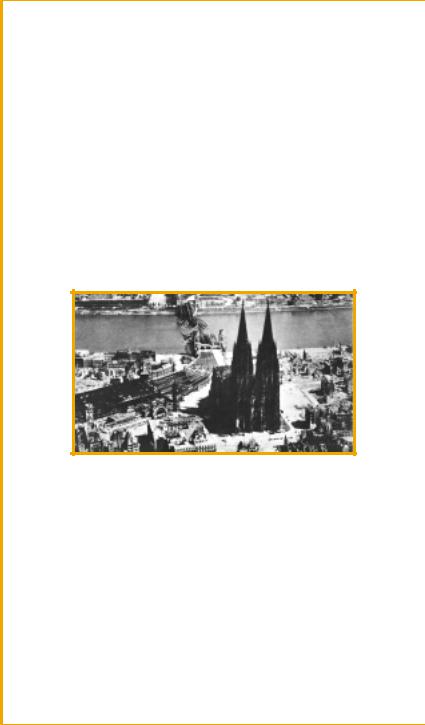
AIR WAR IN WESTERN EUROPE
AIR WAR
in Western Europe
AIR WAR COMES OF AGE
In the First World War, air power emerged as a dramatic new dimension of combat. German dirigibles had bombed London, causing panic. Biplanes and triplanes soared, locked in dogfights over the trenches of France. The men flying the fragile airplanes cut a romantic figure as they rose into the sky. In an era full of fear at the regimentation and mass movement of man, they were a welcome throwback to the knights of old, charging into enemy lines either single-handedly or in small squadrons. Among even the most bitter opponents, there was an almost medieval code of chivalry. Aces such as Baron Manfred von Richthofen (the legendary Red Baron) and his successor Hermann Goering became worldwide celebrities.
Urban devastation: the dream of Douhet and other prophets of air power.
While capturing the imagination, these initial air ventures had little effect on the course of the war. Soon after the conflict ended, however, hints of the future began to emerge. Stronger engines and better designs made new strategies possible. The planes became bigger and faster, and were able to carry heavier loads. The implications of these advances were set forth with chilling vision by Italian Guilio Douhet, in his 1921 book Command of the Air. He declared the era of ground war over; from now on war could be fought and won in the air. Douhet proposed huge flying bombers that could penetrate far behind lines of battle—bypassing the trench warfare that had slowly eaten the morale of First World War armies—and pulverize enemy cities. The resulting panic and destruction would demoralize one’s opponent and bring any war to a speedy conclusion.
3
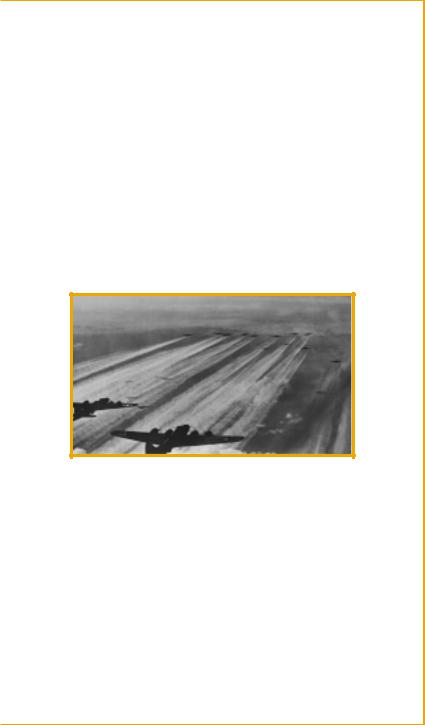
WORLD WAR II FIGHTERS
British and American designers read Douhet’s theories closely. Both began designing large, long-range bombers with the intent, should war come, of taking combat deep inside enemy lines. Both met strong internal resistance to such a strategy: the thought of slaughtering huge numbers of civilians was repugnant to the leadership, especially the American government of Roosevelt. It would be an ironic twist that those most reluctant would be the ones most successful at wholesale urban destruction, culminating in the atomic annihilation of Hiroshima and Nagasaki.
Equally ironic was that those who would goad the Allies into such devastation never put much stock in Douhet’s book. Germany’s rebuilt air power concentrated on the bomber as battlefield support, and their planes were accordingly smaller and with much shorter range. In the initial sweep of war, this would be highly successful. When the time came for attempts at behind-the-lines civilian assault, those most eager to decimate populations would find their air power poorly equipped to help in the project.
AIR POWER AND THE SECOND WORLD WAR
A vast Allied bomber armada heads for Hitler’s Reich.
As the Second World War progressed, the theories of Douhet and another early champion of air combat potential, American William “Billy” Mitchell, would be tested to their utmost. Some ideas proved accurate; others had results far different than those envisioned. Douhet’s belief that urban bombing would demoralize a nation proved quite incorrect when Germany attempted to level British cities in the Battle of Britain. In fact, it united the British people and hardened their resolve to see the war through to its conclusion. Oddly enough, the British leadership failed to learn its own lesson and followed the exhortations of another air power devotee, Arthur “Bomber” Harris, perhaps the war’s most zealous advocate of massive civilian bombing. He was convinced that the German people, unlike his own island’s residents, would crumble and blame their leaders for disaster if subjected to horrific raids. While the economic and strategic results of the massive Allied bombing effort can be argued, the German civilians, like their British counterparts, simply dug in and endured.
4

AIR WAR IN WESTERN EUROPE
If civil collapse was not achieved, Britain alone could not accomplish the other goals of large-scale bombing. It took the entry of the United States into the war for the two nations to combine efforts and strategies and impact the German military machine in a decisive manner. Britain favored night time raids; America confidently chose daylight. Together this round- the-clock bombing strategy aimed to pummel German industry into the ground, and force the Luftwaffe into a defensive position, thus depriving German forces on the front lines of air support.
A burden to bombing strategy was the distance which the planes had to travel. Though equipped with some gun turrets, the bombers were easy targets for fast-moving fighter planes which rose to meet the attack. For raids along the nearby fringes of enemy territory, friendly fighters could fly as escort to the larger planes and fly out to engage enemy fighters. As Allied raids aimed deeper and deeper into German territory, however, the fuel capacity of their fighters forced the tiny planes to turn back often well before the bombers were over their prime targets. Left on their own, the bomber losses were staggering. Champions of heavy bombing such as Harris and American General Carl Spaatz found themselves hard-pressed to justify the losses against the questionable levels of damage inflicted to German military potential.
One result of the Allied bombing offensive that was an unqualified success was its effect on the Luftwaffe. At a time when the tides of battle were turning against Germany, an air force designed for offense and ground support in the field of battle was instead forced to stay on home turf and defend industry and urban sites against an ever-growing enemy swarm. The attrition rate for Allied flyers was horrifying, but the sheer manpower available to the Allies meant losses could be replaced. Germany’s losses were crippling. Skilled pilots were replaced by men who, due to time constraints and scarcity of fuel, had little training. No matter what “miracle weapons” Hitler’s weaponers might design, the skills of those flying them ensured the impact of those wonders would be minimal.
AIR WAR: 1943–44
All across the western front in 1943, air power was playing a critical role. The early mistake Hermann Goering, architect of German air power, made in emphasizing smaller bombers for troop support was now apparent as the four-engine long range bombers of the Allies roared over Germany. At the war’s start, it was the Luftwaffe inspiring terror while screaming over foreign skies. Now, over its own territory, Goering’s air force fought a desperate battle with an enemy growing in strength and confidence.
5

WORLD WAR II FIGHTERS
In late 1942, the Allies escalated saturation bombing to round-the-clock bombing. The British would fly over German cities by night and do their best to utterly destroy them. By day, American bombers would attempt to pinpoint more strategic targets and cripple German industry. American faith in its bombing sights was misplaced, however: the height their planes had to fly to avoid anti-aircraft artillery often negated any accuracy those sights might provide. Bombs often fell miles from their target.
An American Liberator succumbs to German air defenses.
In summer 1943 the Allies bombed Hamburg for four consecutive nights, taking 40,000 lives and creating a huge firestorm. The citizens—those who survived—were stunned and numbed, but did not turn on their leaders. In August, American planes from Libyan bases reached Ploesti, Romania’s huge oil facility. As they flew over the Balkans, wave after wave of Luftwaffe fighters rose and hammered them. A quarter of the men on the mission died. Slightly more than one-sixth of the planes survived or were able to be flown again. The facilities were soon repaired and operational.
For both sides, losses were terrible. The Luftwaffe were losing pilots at a speed too great to replace. By late 1943, most planes rising to meet the huge fleets of Allied bombers with their swarms of fighter support were piloted by men with much less training, let alone battle experience. As for the Allies, their fighter planes could not make the longer journeys to support the bombers. As better fighters were built and their range increased, more German targets could be reached, but at a certain point, they had to turn back—and then the Luftwaffe and its speedy planes could tear the bombers to pieces. It would not be until 1944 that additional gas tanks called ‘drop tanks’ would enable Allied fighters such as the P-51 Mustang to penetrate deep into Nazi territory and destroy the Luftwaffe.
Equally dreaded was the 88 mm antiaircraft gun. Closely concentrated, dug in near vital industrial areas and other targets sure to attract Allied air raids, Flak guns may have taken out more bombers than the Luftwaffe throughout the course of the war.
6
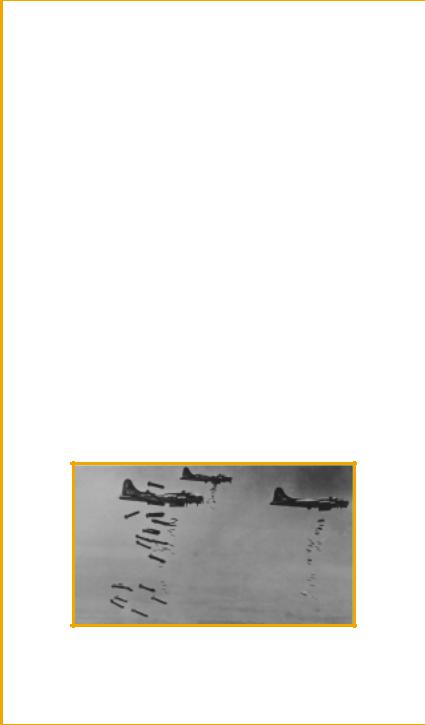
AIR WAR IN WESTERN EUROPE
Amazingly, though fuel and pilots were scarce, fighter production continued to rise in Germany. Hitler’s new minister of production, Albert Speer, had reorganized the economy and cut as best he could through the multiple layers of squabbling bureaucracies to actually increase all-around military production. This in the face of round-the-clock bombing raises questions as to the strategic, as opposed to propagandistic, value of the constant raids.
One definite result of round-the-clock bombing was that the Luftwaffe was being slowly bled dry. While not destroying German industry, the bombing strategy had pinned Goering’s forces down on the home front. While more planes were being built, they couldn’t keep pace with the losses sustained against the Allies. Hitler began putting more and more hope— and more and more resources—into a host of experimental weapons he believed would turn the tide again to his favor. Goering, desperate to regain favor, encouraged his Führer in those dreams. And in the East, the loss of air support to defense over Germany left the Wehrmacht open to the grinding, inexorable advance of the Red Army.
COUNTDOWN TO INVASION
By now the path of the war had become plain, like a hideous ballet whose choreography had been planned and now must be followed through. German High Command knew that eventually the Western Allies were going to strike across the English Channel and fortifications were accordingly built. Generalfeldmarschall Erwin Rommel, considered one of Germany’s best generals, was brought north from overseeing the occupation of what was left of Mussolini’s regime to supervise the anticipated defense of the beaches. He immediately began construction of an elaborate series of defenses. If invasion came, he thought, and the Allies could be repelled on the beaches, it would be years before they could muster another assault.
B-17s unload their “sticks” on the target.
7

WORLD WAR II FIGHTERS
Hitler too hoped for a decisive blow on the beaches. In the face of the crushing defeats being dealt the Wehrmacht in the East, he was still convinced he could triumph over his enemies. He moved many of his best divisions to France and the Low Countries to wait for the invaders and smash them on the beaches. From there, holding them in the Italian bottleneck would be easy. Full force could be concentrated on the Soviets, who would then crumble. Hitler could then choose the time and place for his victorious attack against the West.
Unfortunately for the Führer, his visions of destiny combined poorly with faulty Nazi intelligence gathering. Allied diversions led German High Command to grossly overestimate the size of the invasion force gathering in England. Thus, more German divisions were held down in France, just as the Red Army was hitting high gear in its most brutal offensives yet. Further Allied deception tricked Rommel into positioning most of the finest armor and best troops far away from the actual landing point. As newlyappointed Supreme Allied Commander Dwight D. Eisenhower polished plans for a Normandy landing, the best Germany could throw against an attacker was waiting to the east, convinced the Allies would make a straight line from Dover to Pas de Calais. Any landings to the west, thought Rommel, were diversionary attacks to be disregarded and dealt with later.
Meanwhile, Allied round-the-clock bombing continued its relentless pounding of the German landscape. The Luftwaffe was slowly being whittled away. Though Albert Speer was achieving sinister miracles in keeping armaments production high, damage to transportation infrastructure and the massive consumption of fuel by units engaged to the south and east meant that poorly trained pilots were rising to meet Allied flyers. The few skilled German pilots left were busy testing the secret weapons Hitler was always boasting of, the weapons that in his wild inner world would turn the tide of war. Allied bombs had hindered development of his V-2, the world’s first rocket weapon, with which he hoped to bring the Blitz back to London. With their debut put off by a year, the Führer instead demanded a renewed conventional bombing assault on England at the start of 1944. The Luftwaffe thus squandered precious planes on a futile “Baby Blitz”, as Londoners called it. Until May 1944, a force of 500 bombers inflicted minimal damage as Allied air defenses blasted more than half of them out of the sky.
In the East, the Red Army continued slowly steamrolling over the Wehrmacht. Their 1943–44 winter offensive gave the Germans no rest. By spring 1944, Germany was in full retreat in the East. The Soviets had their choice of where to strike first. Reinforcements poured into the Red Army; its Ural industrial base, untouched by Axis assault, sent a steady stream of weaponry toward the front. The Germans in the East, on the other hand, were increasingly desperate. Reinforcements and new weaponry were being sent westward, to guard the beaches of France. Partisans roamed behind the lines freely, pinning down Nazi troops, destroying supply lines
8
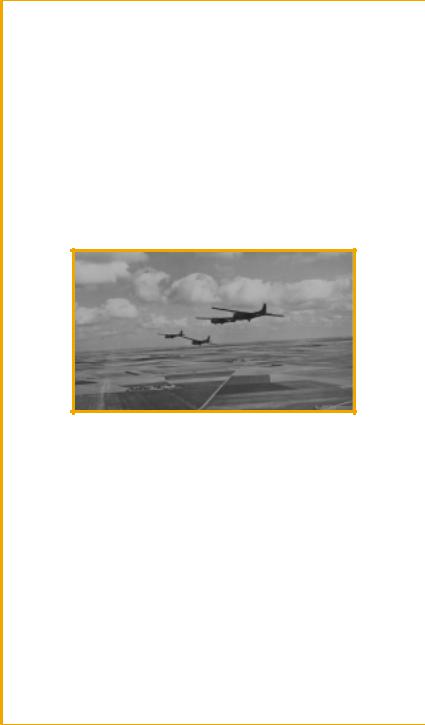
AIR WAR IN WESTERN EUROPE
and communications. Years of slaughtering Soviet officers and starving prisoners of war had made their enemy a merciless, furious foe. No German wanted to be taken prisoner by the Red Army. It was a virtual death sentence.
In Italy, the first of the Axis nations to be invaded, the Allies saw a much slower advance. Given terrain, climate, and the proximity to the Reich itself, the German defense was more tenacious, despite the Italian populace’s eager embrace of the Allied assault. The fighting was slow, torturous, and bloody, with only more devastation likely as the Allies would slug their way up the narrow peninsula. But as Italy and her liberators looked ahead, the only thing that could shorten the bloodshed was on the horizon: the attack from the west. The time had come at last for D-Day.
D-DAY
Gliders carrying troops into Normandy.
Operation Overlord, the largest amphibious assault ever undertaken, began on June 5, 1944, during a break in an unexpected storm which nearly forced Supreme Allied Commander Dwight D. Eisenhower to call off the invasion. Due to amazingly successful Allied deception as well as the bureaucratic stupidities and inept intelligence-gathering of the Germans, the landings were a surprise.
Massive air power had been called in. For weeks, bombing runs had been softening up the coastal defenses, and surveillance flights had pinpointed the major installations. Even Arthur “Bomber” Harris put aside his usual obsession with terror bombing and committed his forces to aiding the invasion, devastating the rail lines and infrastructure Germany needed if it was to respond quickly to the assault. Allied fighters and bombers ruled the skies: the Luftwaffe’s ill-advised “Baby Blitz” had left it even weaker than it already was, and the landing sites were all within range of fighters based in England.
9
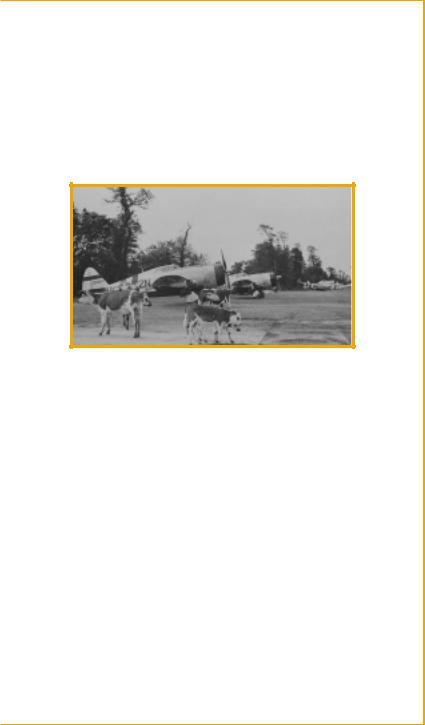
WORLD WAR II FIGHTERS
The Germans were taken in by almost every Allied diversion. Dummy parachutists convinced Rommel that his instincts were correct: the forces landing at Normandy were simply a diversionary attack. He refused to be fooled; his main forces, including prized panzer divisions which might have blown the landing troops to pieces, remained to the east, and would stay there for crucial days to come. Surely the main landing would come at one of the strategic harbors the Germans held, and had built impenetrable defenses around. What Rommel didn’t know was that the Allies had built two floating harbors of their own, and that these huge devices were on their way across the channel.
American Thunderbolts meet French livestock on a temporary runway.
The key to victory was landing as many forces as fast as possible, and the Allies succeeded brilliantly. Before the Germans realized the main invasion really was happening and could get reinforcements to contain the beachheads, the floating harbors had unloaded artillery, armor, and thousands of men. Even a terrific storm’s destruction of one of the artificial harbors on June 19 couldn’t help the Germans. The first day’s hesitations cost them the battle. Their numerical superiority in troops and armor was too slowly deployed, and their air defenses had been shattered by wave after wave of Allied planes.
Still, the destruction was terrible. The defenders gave ground grudgingly, fighting field by field, inflicting heavy losses on Americans in the west and the British further east. But after bitter initial fighting, by the 14th the Americans, under the colorful General George Patton, had broken through German lines and drove toward Cherbourg, which fell on the 26th. The Allies now had a true harbor through which they could pour weaponry and supplies. The Nazis had done their best to destroy the city and its harbor, but within three weeks Cherbourg was beginning to unload further invasion forces.
10

AIR WAR IN WESTERN EUROPE
The Allies had firmly established themselves on the continent, though progress was slower than initially anticipated. Field Marshal Bernard Montgomery, the hero of El Alamein, the crucial battle which turned the tide against Germany in North Africa, was unwilling to take the heavy losses a major British push would entail. The Americans to the west found themselves in terrain which hindered the advance of their heavy armor. Once they attached gigantic spikes to the front of their tanks, however, they could go off road again, punching through the hedgerows of northern France and into the face of the ferociously-resisting Germans.
As American armor hammered in the west, to their east, Nazi armor was doing its best to push the British back to the beaches. But from the air came swarms of Allied fighters and bombers, pinning the tanks in their positions, making movement slow and deadly. Round-the-clock air attacks from Allied planes and futile offensives had left the Luftwaffe, in the hour it was most needed, outnumbered and outgunned.
From Berlin, Hitler made a confusing situation worse, issuing contradictory orders, berating, ignoring, and overruling his generals. He refused calls for a counterattack against the menacing American armor which threatened to buckle the entire defensive line in France. He didn’t want to risk the army; instead it began to be whittled and chipped away as it was slowly pushed back, with no reserves to replace the losses.
Meanwhile, his fervent belief in his secret weapons program finally bore fruit in mid-June. The first V-1’s, pilotless jet planes loaded with explosives, began falling on London. Although the appearance of these odd bombs were a blow to British morale—Churchill even demanded retaliatory poison gas attacks, but was overruled by the Americans—actual damage was nowhere near as great as Hitler envisioned. The V-1’s were easily shot down, and many others missed their London target. Panic did not set in; London was not evacuated; the Allied war effort continued unhindered. Once again Douhet’s predictions failed to come true. The weapons designed to suddenly win the war only hurried the Allies to break out of the Normandy beach heads to reach the V-1 launch sites.
Nazi generals finally got the hint that Normandy was, indeed, the big landing by late July and began moving their long-sidelined armor from Pas de Calais to intercept American tanks. By then the difficult terrain was behind Patton’s forces, however, and open country well-suited for armor was now before the audacious general. Hitler finally agreed to a counterattack at Mortain, and issued orders to strike—orders which were intercepted and decoded by the Allies, who had broken almost all the German codes and knew exactly when and where the attack was to come. Allied air power, combined effectively with the ground troops, stopped the assault in its tracks. As the Americans pummeled their attackers, the British and Canadians previously pinned down by those German troops moved south. Had Montgomery not once again been too cautious and held back his best
11

WORLD WAR II FIGHTERS
troops, the Germans would have been trapped and annihilated in another Stalingrad. As it was, many of them escaped, although with huge losses in life and equipment. By late August, the British were clearing Belgium and capturing the V-1 launch sites, and to the south, defying Hitler’s orders to level the city, Gen. von Choltitz pulled out of Paris. On August 25, advancing American troops held back and let Charles de Gaulle’s Free French forces liberate their long-suffering capital. Ten days earlier, more Allied troops had struck from the south, landing on the French Mediterranean coast. Churchill had heatedly opposed this operation, pushing instead for continued pressure in Italy. Given the choice of advancing slowly to an Alps range filled with Nazis armed to the teeth or seizing the ports of Marseilles and Toulon, Eisenhower understandably overruled the British prime minister’s strategy.
The German lines were crumbling. From the Low Countries to the Swiss frontier, Allied troops were racing toward the borders of the Reich. Hitler grudgingly allowed the troops in the south of France to pull back and avoid encirclement. Almost all of France had been taken in two months’ fighting. With the Nazi armies went the wartime French government based in Vichy. Coming to power through French defeat, they now faced disaster of their own as France was freed, having tied themselves to the fate of their conquerors. From southwest Germany, they watched as the Wehrmacht abandoned France and regrouped along the border, holding as many Low Country ports as it could.
That holding of ports became ever more troublesome for the Allies as 1944 progressed. While Cherbourg was slowly being cleared, other liberated ports such as Brest had been so badly wrecked by the retreating Germans that they were unusable. As Germany’s supply lines shortened, lessening the strain on its battered infrastructure, the Allied lines stretched forward, with huge levels of troops, planes, tanks, and artillery to maintain. The damage they had done to infrastructure to cripple Nazi supply lines now haunted them. The only thing that helped them get as far as they did before supply became a major issue was the valiant drivers of a massive convoy of trucks laden with fuel and weapons which came to be called the Red Ball Express. A round-the-clock substitute for the ruined rails ran nearly 90,000 tons of supplies from the landing beaches of Normandy deep into France in the space of a few weeks.
By the time the Allies were closing in on the Reich, even that fuel was running low. Patton and Montgomery bickered over who should get the last fuel reserves and push ahead. Eisenhower sided with the difficult British general, who planned to force his way across the Rhine into Holland, allowing the Allies to exploit the great harbor of Antwerp, which the British had seized virtually intact. Montgomery swung from his usual toocautious approach to overconfidence. Ignoring warnings of strong German armor nearby, he ordered a parachute brigade dropped behind enemy
12
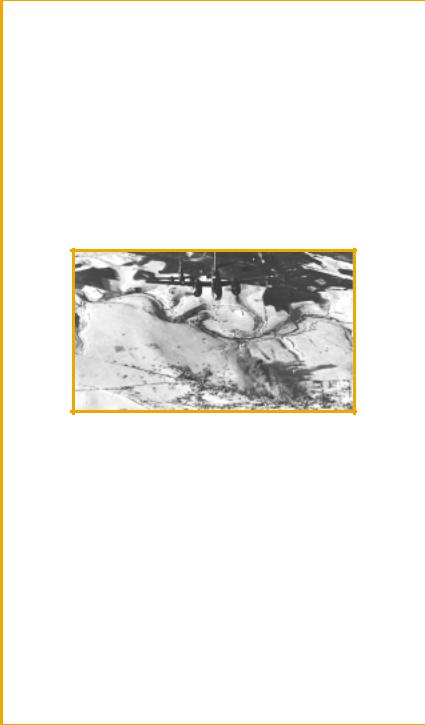
AIR WAR IN WESTERN EUROPE
lines—and on the other side of town from the Arnhem bridge the paratroopers were to seize. The Germans cut them off, drove them away from the bridge, and shot them to pieces. Only a fifth of them survived to become prisoners or escape back across the Rhine.
Surprised by the stiffening German resistance, stunned by Montgomery’s defeat, and above all, desperately low on fuel, the Allied advance slowed as autumn progressed. Eisenhower had hoped for an end to war in Europe by autumn; an obstinate Reich had held out. The Allies would have to wait until spring—winter was coming, and conditions would be too poor for any major offensive on the Western front. Eisenhower’s only solace was that, given the weather and the continuous beating Germany was taking in the East, at least Hitler couldn’t launch any counterattacks either.
THE ARDENNES OFFENSIVE
Allied medium bombers over “The Bulge.”
Hitler counterattacked on December 16, 1944, stunning the Allies by sending forth troops and armor under cover of fog and cold. Now, with the Eastern front in collapse and his final attempts at terror bombing London out of the war proven futile, he decided on a final, furious offensive that might change the course of the war.
While on the Eastern front the amount of territory between Germany and the Soviets was ample, in the West the front was uncomfortably close to the Reich’s industrial base. While there might be time to stall and regroup against the Soviets, there was little time to waste before the Allies would be in the vital Ruhr region. Thus, as entire armies were being annihilated on the Polish frontier, Hitler massed more than twenty divisions of new troops and equipment in the West, augmenting it with the last reserves of manpower he could find within the Reich. Total mobilization had finally been declared by Speer. Now 16-year-old boys sat in the cockpits of the Luftwaffe’s fighters and filled the ranks of German rifle companies.
13
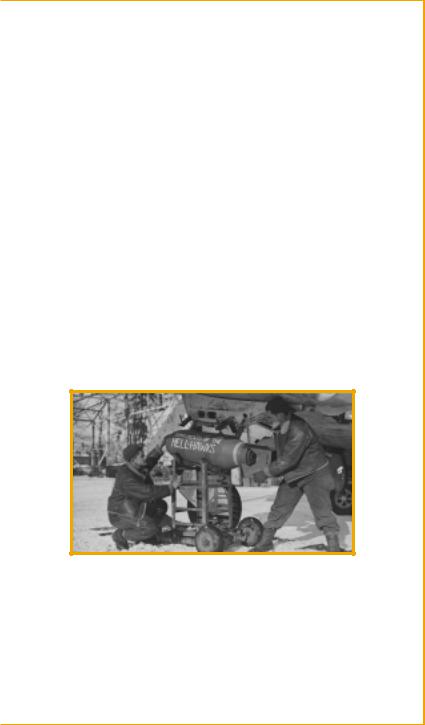
WORLD WAR II FIGHTERS
Hitler planned to deliver a stunning, crushing blow, pushing the Allies across the Channel in a second Dunkirk. This new Blitzkrieg would undoubtedly be so successful that it would end in time to switch the forces back to the East before the Soviet winter offensive would begin. Hitler’s estimation of the Allies, especially the Americans who now made up the bulk of the force in the West, was that they were a weak-willed assembly, ready to crack with the first serious defeat. For the third time in less than fifty years, Germany planned a sudden attack through the Low Countries.
Allied intelligence summed up the Wehrmacht as a spent force, unable to muster anything beyond a tenacious but doomed defense. Over the skies of Germany, Allied bombers flew virtually unopposed, pulverizing cities with impunity. The vast resources of Ukraine and Romania were in Soviet hands; only the oil fields of Hungary remained for Hitler to draw upon. The Allied lines were drawn thin across the Ardennes forest, but could hold firm until supplies arrived and a spring offensive could begin.
It was with this mutual underestimation that the last Nazi offensive began. In cold and snow, through the heavy woods of Luxembourg and Belgium, a 400,000 man German force slammed into a front guarded by 80,000 Americans who were outnumbered in tanks and (by a more than four-to- one ratio) artillery. In the long-gone days of 1940, the attack would have waited for a clear day, so that the mighty Luftwaffe could first bludgeon the enemy from the air. In 1944, the Germans instead counted on poor weather to keep the Allied air forces’ far superior strength on the ground.
American ground crewmen prepare a holiday gift for the enemy.
The Americans were caught totally off-guard. Eisenhower scrambled to move forces to the Ardennes as two divisions were destroyed and others were pushed back toward the strategic town of Bastogne. A division of US paratroopers secured the town just in time; the Germans surrounded it but failed to take it. This slowed the advance toward the Meuse River, giving American armor time to regroup and stop the attack on the water’s east side.
14

AIR WAR IN WESTERN EUROPE
To the south sat the American 3rd Army. Patton had been waiting for the fuel to take his attack east into Germany. When the sudden offensive began, Allied command was alarmed at the sparse defenses in the German path, and the time it would take distant reinforcements to arrive. To everyone’s astonishment, Patton promised them he could disengage in the Saar, change direction, and swing north to relieve Bastogne in 48 hours. To everyone’s further astonishment, he did just that, not only getting his forces to the front but hurling them into combat against the German armor besieging the city. He smashed his way through in the face of brutal panzer counterattacks, breaking the iron ring around Bastogne and freeing the pinned 101st Airborne Division.
Despite the help Montgomery’s timidity gave them, the Germans’ bout of good luck came to an end on Christmas Eve 1944, when the bad weather which kept the Allied air forces grounded gave way. In the cold, clear skies over the Ardennes, over 3,000 planes took to the air, and aimed for the slowly stalling German advance. To the east, the Luftwaffe had orders to attempt yet another air offensive against the enemy. Untrained pilots with little ammunition and less fuel climbed into what was left of the Luftwaffe with visions of chasing the Allied planes (by now outnumbering them ten-to-one) from the sky.
So the Allies and Nazi Germany found themselves, on the Western Front, in desperate battle. Hitler was flinging his last reserves in a final assault, convinced he could sweep his enemies into the Atlantic and buy time to win in the East. Both sides prepared to throw all they had into this showdown for control of the war’s direction, and perhaps its outcome. At the end of 1944, the future of the planet was being decided on the ground and in the skies above the dense forests of the Ardennes. The West had to get reinforcements to the lines before they were overwhelmed, and hope for the weather to clear so their superior air power could be deployed.
15
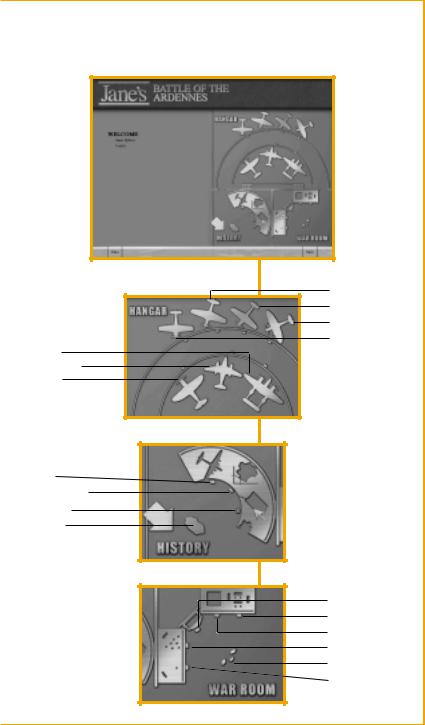
WORLD WAR II FIGHTERS
MUSEUM MAP
P-51D
BF 109G-6
SPITFIRE F. IX
FW 190A-8
P-38J
ME 262A-1A
P-47D
AIR FORCES 
HISTORICAL OVERVIEW
GROUND FORCES
WELCOME DESK
MULTIPLAYER
QUICK MISSION
MISSION BUILDER
CAMPAIGN
ACES
SINGLE MISSION
16
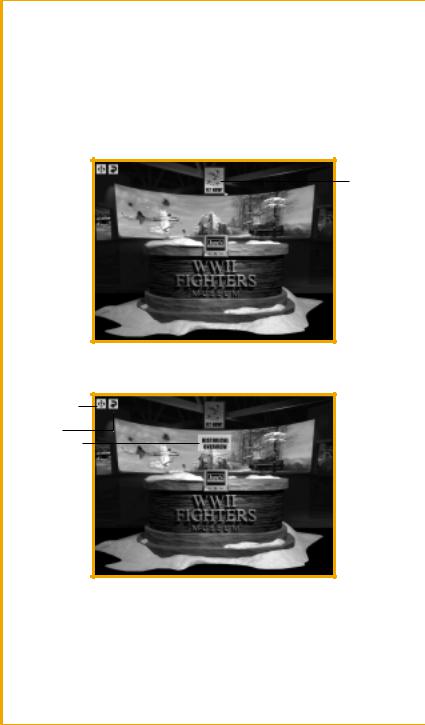
THE EXHIBITIONS
THE EXHIBITIONS
Upon entering the museum, you see the Welcome Kiosk. If you want to jump right into flight, click the Fly Now! poster hanging in the top center of the screen. You immediately begin a quick mission without configuring your flight.
JUMP DIRECTLY
INTO A MISSION
NAVIGATING THE MUSEUM
QUICK NAVIGATION
BUTTON
BACK BUTTON
CLICK ON AN ACTIVE
LABEL TO MOVE
FORWARD
To go to the previous screen, left-click the BACK button in the top left corner of the screen.
Use the QUICK NAVIGATION button to jump to another part of the museum. Click to bring up a screen listing the various locations in the museum. Select a location to be instantly transported there.
17
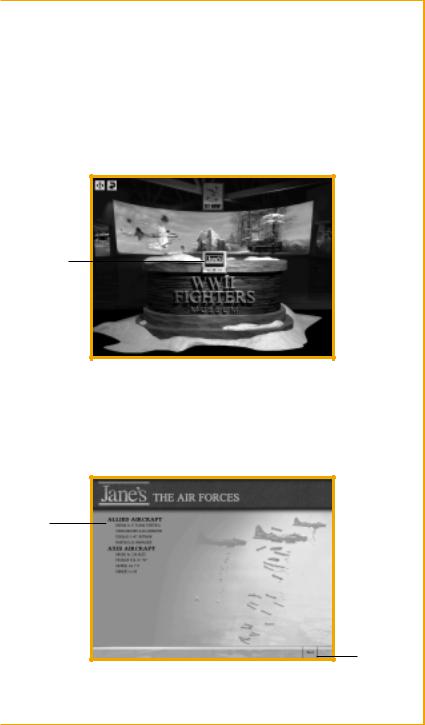
WORLD WAR II FIGHTERS
PANNING YOUR VIEW
At some locations, you may need to pan your view in order to see everything before you. To pan your view, move the mouse cursor to the left or right side of the screen.
VIEWING KIOSKS
Each museum room has a number of kiosks. When you move the mouse over a kiosk, it lights up. Click on a kiosk to view the content at that station.
CLICK ON KIOSK
TO VIEW CONTENT
The content you see on a kiosk monitor varies. Some kiosks display information on vehicles or historical subjects. Others select a mission.
INFORMATION KIOSKS
All Information Kiosks have a contents page. Here you choose the subject about which you want to learn.
CONTENTS
BACK
18
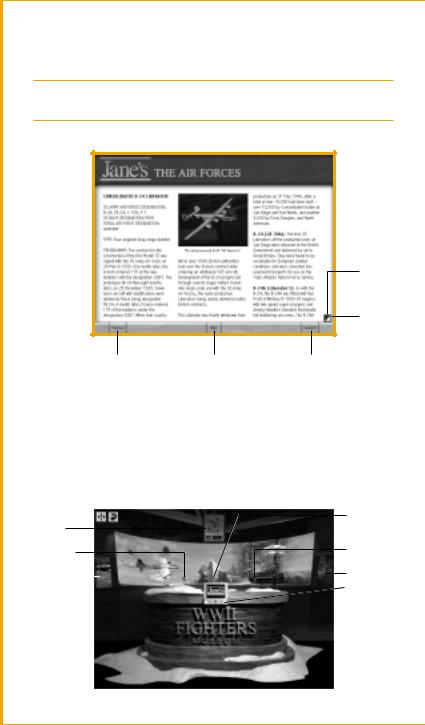
THE EXHIBITIONS
When you move your mouse over the contents page, the option under the mouse turns white. Click to view detailed information on the subject. Select the BACK button to exit the kiosk screen.
Video Button: Many kiosks have an additional Video button. Use this to watch video reference material on the current subject.
Viewing Information
GO TO THE
PREVIOUS
PAGE OF
INFORMATION
GO TO THE
NEXT PAGE OF
INFORMATION
DISPLAY THE PREVIOUS |
DISPLAY THE NEXT |
RETURN TO THE |
SUBJECT IN THE CONTENTS |
SUBJECT IN THE CONTENTS |
CONTENTS PAGE |
Mission Kiosks
The Mission Kiosks are found only in the War Room. The controls in the mission kiosks vary depending on the type of mission. See the Gameplay Guide included in your Jane’s® WW II Fighters box for information on selecting missions and building your own missions.
WELCOME DESK
|
|
|
|
GO TO HISTORICAL |
JUMP DIRECTLY |
|
|
BACKGROUND |
|
|
|
KIOSK |
||
INTO A MISSION |
|
|
||
|
|
|
||
GO TO AIR FORCES |
|
|
GO TO GROUND |
|
|
|
FORCES KIOSK |
||
KIOSK |
|
|
||
|
|
|
||
|
|
|
|
GO TO WAR ROOM |
GO TO HANGAR |
|
|
||
|
|
|
||
|
|
|
|
SET GAME OPTIONS, |
|
|
|
|
VIEW CREDITS, OR |
|
|
|
|
WATCH THE GAME |
|
|
|
|
INTRO ANIMATION |
|
|
|
|
|
19
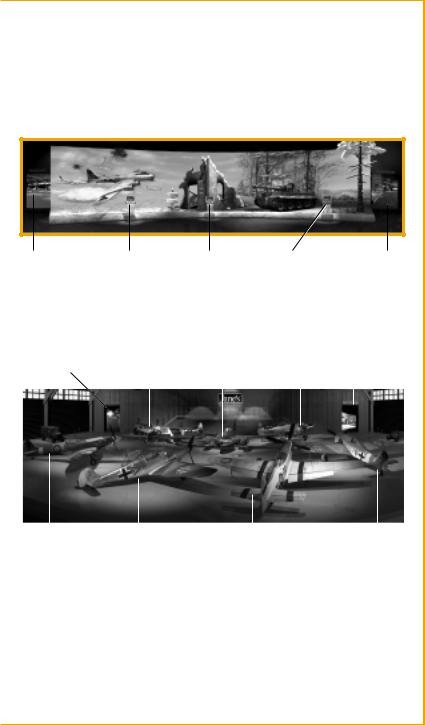
WORLD WAR II FIGHTERS
INFO ROOM
In the Info Room, you can learn about bombers and other aircraft that operated over Europe, as well as the types of ground vehicles and weapons that operated on the Western Front in late 1944. Also, the Historical Background Kiosk provides you with information on the Ardennes Offensive, known in the US as the Battle of the Bulge.
GO TO HANGAR |
VIEW INFORMATION |
VIEW HISTORICAL |
VIEW INFORMATION |
GO TO WAR ROOM |
|
ON ALLIED AND |
BACKGROUND ON |
ON ALLIED AND AXIS |
|
|
AXIS BOMBERS |
THE ARDENNES |
GROUND VEHICLES |
|
|
AND TRANSPORTS |
OFFENSIVE |
|
|
HANGAR
In the Hangar, you can learn about the museum’s featured aircraft.
GO TO INFO ROOM |
GO TO P-38J |
GO TO ME 262A–1A |
GO TO P-47D |
GO TO INFO ROOM |
||||||||||
|
|
|
|
|
|
|
|
|
|
|
|
|
|
|
|
|
|
|
|
|
|
|
|
|
|
|
|
|
|
|
|
|
|
|
|
|
|
|
|
|
|
|
|
|
|
|
|
|
|
|
|
|
|
|
|
|
|
|
|
|
|
|
|
|
|
|
|
|
|
|
|
|
|
|
|
|
|
|
|
|
|
|
|
|
|
|
|
|
|
|
|
|
|
|
|
|
|
|
|
|
|
|
|
|
|
|
|
|
|
|
|
|
|
|
|
|
|
|
|
|
|
|
|
|
|
|
|
|
|
|
|
|
|
|
|
|
|
|
|
|
|
|
|
|
|
|
|
|
|
GO TO SPITFIRE F. IX |
GO TO BF 109G-6 |
GO TO P51D |
GO TO FW 190A-8 |
VIEWING THE AIRCRAFT
When viewing an airplane, you can go take a closer look at the cockpit, armament, and powerplant. The curator provides commentary on each aspect of the airplane.
20
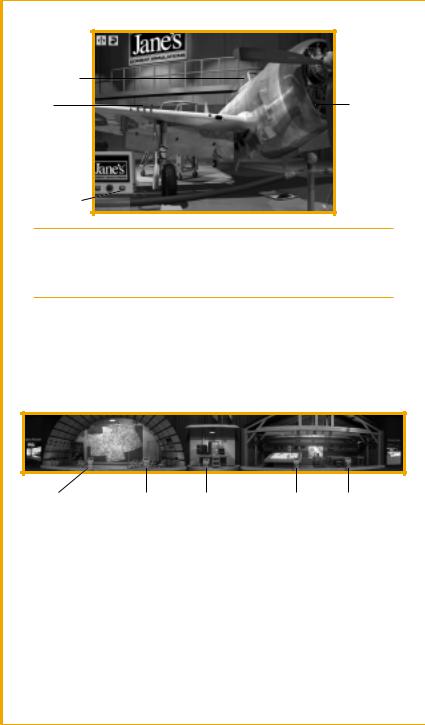
THE EXHIBITIONS
GO TO THE COCKPIT |
|
GO TO THE |
GO TO THE ENGINE |
ARMAMENT |
COMPARTMENT |
VIEW INFORMATION
ABOUT THE AIRPLANE
Special Test Flight Buttons: Each of the Airplane Kiosks in the Hangar has a Test Flight button. Click this to fly the airplane of your choice in a non-hostile environment. Here you can test your flying and gunnery skills.
WAR ROOM
In the War Room, you can select a single mission, build a custom mission of your own, start or continue a campaign, or join a muliplayer game. In addition, a special Aces Kiosk has video interviews with the aces who flew the actual planes.
GO TO SINGLE MIS- |
GO TO CAMPAIGNS |
GO TO MULTIPLAYER |
GO TO MISSION |
GO TO QUICK MIS- |
SIONS KIOSK |
KIOSK |
KIOSK |
BUILDER KIOSK |
SION KIOSK |
SELECTING MISSIONS
The controls in the mission kiosks vary depending on the type of mission. See the Gameplay Guide included in your Jane’s WW II Fighters box for information on selecting missions and building your own missions.
21

WORLD WAR II FIGHTERS
JANE’S® WW II FIGHTERS
Museum Collection
In the 1930s, the antiquated, wooden biplanes of WW I were replaced by a new generation of sleek, metallic monoplanes that would redefine combat. Improvements in the engines, airframes, and firepower of these new aircraft fostered the great race of the decade—which country could create the fastest, most destructive flying machine in the world.
FOCKE-WULF FW 190A-8
Germany prepared for war with the expectation that mobile warfare and combined arms would make any future conflict a brief if violent affair. It was widely believed that a successor to the Luftwaffe’s frontline fighter, the Messerschmitt Bf 109, would hardly be necessary in the age of Blitzkrieg warfare. Thus it was with unusual foresight that the Reichsluftfahrtministerium (RLM), or Air Transport Ministry, chose to fund the development of an air superiority fighter in 1938, just as the Luftwaffe was standardizing on Messerschmitt’s outstanding fighter. Who would have guessed then that a particularly compact airplane—designed by Kurt Tank and his team at Focke-Wulf—would become one of the most successful propeller-driven fighters ever produced in great numbers?
Certainly the officials at the RLM did not expect much from Tank’s machine. True, the airplane was small and sleek, with an attractively thin fuselage, extremely low-drag profile, and excellent structure. But the fact that it was built around a bulky radial engine instead of a narrow inline engine did not bode well for its future. Three prototypes powered by 18-cylinder BMW 139 radial engines were ordered and built, the first flight occurring in early June 1939. The engines were found to be wanting and were replaced by the heavier but more powerful 1,192 kW (1,600 hp) BMW 801C. The added weight forced some changes in the airframe, including moving the cockpit further aft in order to shift the center of gravity; combined with a now larger engine cowling, the pilot’s view was diminished slightly. The wing was also lengthened, though this was more beneficial than detrimental.
Trials with pre-production aircraft revealed teething trouble with the airplane’s ten-blade cooling fan, but the overall impression of the fighter was that it was a delight to fly. Orders were delivered for a hundred Fw 190A-1 aircraft armed with four 7.7 mm MG 17 machine guns—two in the cowling and another pair in the wing roots—all firing through the propeller. To increase firepower, 20 mm MG FF cannons were added to points outboard of the landing gear. By the time the A-2 arrived, the wing root guns were being replaced by the new 20 mm MG 151/20, necessitating the bulged plates on the upper wing surfaces.
22

MUSEUM COLLECTION
It was the Fw 190A-3 powered by the 1,268 kW (1,700 hp) BMW 801D-2 that became a menace to the RAF in the summer of 1942. Flying against Spitfire Vs, the Fw 190s proved themselves in every category of performance save turning ability. Able to initiate or break off combat at will, the Fw 190s dominated the skies over northwest Europe. The power of the new fighter was such that the English would have to scramble to wrest air superiority from a smaller Luftwaffe force facing them across the channel.
A number of Fw 190A sub-variants followed to fulfill an ever-widening number of roles. Originally intended to be an air superiority fighter, the Würger (“butcher bird”) quickly became a jack-of-all-trades, armed with cameras for reconnaissance; external fuel tanks for long-range missions; bombs for use as a fighter-bomber; tropical equipment for desert-fighting; wing pods for use as a bomber-destroyer; additional armor for bomberramming; radar equipment for use as a night-fighter; bomb racks for carrying torpedoes; and various combinations of the above.
As the war progressed, the Fw 190 assumed roles earlier held by such esteemed German aircraft as the Ju 87 Stuka and other close support aircraft. Beginning in late 1942, the heavily-armored Fw 190F—which also featured an incredible number of sub-variants—was developed for use in the ground attack role. This was followed by the 190G series, a close support version with additional fuel for increased combat range.
As the radial engine Fw 190 was being perfected, Focke-Wulf simultaneously developed versions of the fighter (190B and C series) with inverted-V liquid-cooled inline engines. The radial engine 190s performed poorly at high-altitude, and as defense of the Reich took on importance, the need for a heavily-armed high-altitude fighter became greater. The result was the famous 190D or “Dora” series of fighters, which began to see service only in late 1944. Powered by a 1,323 kW (1,776 hp) Junkers Jumo 213A-1 engine, the Fw 190D was considered on a competitive footing with the P- 51 or Spitfire IX.
In total, just over 20,000 Fw 190s of all types would be produced by war’s end.
FW 190A-8 DATA
Engines |
One 1,268 kw (1,700 hp) BMW 801D-2 |
Wing Span |
10.5 m (34 ft 5.5 in) |
Length |
8.96 m (29 ft 4.75 in) |
Max T-O Weight |
4,900 kg (10,802 lb) |
Max Level Speed |
657 km/h (408 mph) |
Range |
800 km (497 mi) |
Armament |
Two 12.7 mm machine guns, two 20 mm cannon, |
|
and either two-four 20 mm or two 30 mm cannon |
23
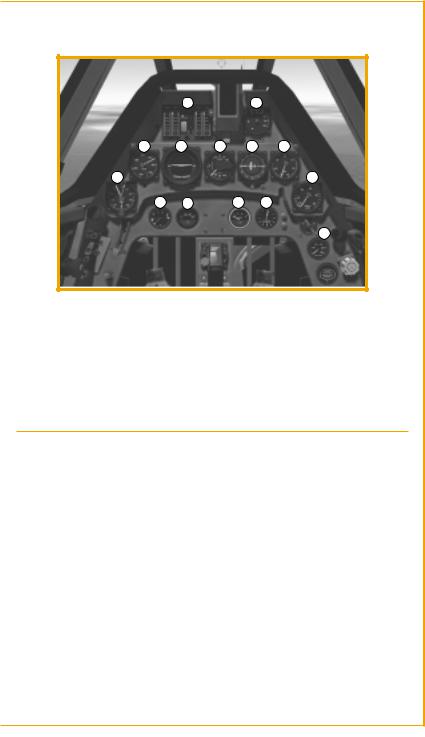
WORLD WAR II FIGHTERS
FW 190A-8 COCKPIT
|
1 |
|
|
2 |
3 |
4 |
5 |
6 |
7 |
8 |
|
|
|
9 |
10 |
14 |
|
11 |
12 |
13
1. |
AMMUNITION COUNTER |
8. |
ALTIMETER |
2. |
RADIO DIRECTION FINDER |
9. |
TACHOMETER |
3. |
AIRSPEED INDICATOR |
10. |
FUEL AND LUBRICANT PRESSURE GAUGE |
4. |
ARTIFICIAL HORIZON |
11. |
FUEL GAUGE |
5. |
RATE OF CLIMB INDICATOR |
12. |
CLOCK |
6. |
COMPASS |
13. |
OXYGEN PRESSURE INDICATOR |
7. |
BOOST |
14. |
ENGINE TEMPERATURE |
FW 190A-8 GAME LOADOUTS
|
|
|
|
|
Fuel, |
|
|
|
|
Clean |
|
Gun Pods |
Gun Pods |
500 kg |
250 kg |
|
|
|
|
|
|
|
|
Primary Guns |
Type/Number |
20 mm x 4 |
x 4 |
20 mm x 2 |
20 mm x 2 |
20 mm x 4 |
20 mm x 4 |
|
Location |
Wing/ |
Wing/ |
Wingroot |
Wingroot |
Wing/ |
Wing/ |
|
|
Wingroot |
Wingroot |
|
|
Wingroof |
Wingroof |
|
Rounds/Gun |
200 |
|
200 |
200 |
200 |
200 |
|
|
|
|
|
|
|
|
Secondary Guns |
Type/Number |
13 mm x 2 |
x 2 |
13 mm x 2 |
13 mm x 2 |
13 mm x 2 |
13 mm x 2 |
|
Location |
Cowling |
Cowling |
Cowling |
Cowling |
Cowling |
Cowling |
|
Rounds/Gun |
475 |
|
475 |
475 |
475 |
475 |
|
|
|
|
|
|
|
|
Secondary Guns |
Type/Number |
– |
– |
30 mm x 2 |
30 mm x 2 |
– |
– |
|
Location |
– |
– |
Wing Pods |
Wing Pods |
– |
– |
|
Rounds/Gun |
– |
– |
55 |
55 |
– |
– |
|
|
|
|
|
|
|
|
Bomb Load |
Type |
– |
– |
– |
– |
500 kg |
250 kg |
|
Location |
– |
– |
– |
– |
Centerline |
Centerline |
|
Number |
– |
– |
– |
– |
1 |
1 |
|
|
|
|
|
|
|
|
Drop Tank |
Type |
– |
|
– |
300 ltr |
– |
– |
|
Location |
– |
Centerline |
– |
Centerline |
– |
– |
|
Number |
– |
1 |
– |
1 |
– |
– |
|
|
|
|
|
|
|
|
24

MUSEUM COLLECTION
LOCKHEED P-38 LIGHTNING
Developed before the war for use as a long-range, high-altitude fighter, the P-38 took on a wide variety of additional combat roles, including escort, fighter-bomber, photo-reconnaissance, torpedo-bomber, light transport, and even an airborne ambulance. The adaptable Lightning served until the end of the war—the only fighter to precede the war and remain in production until Japan surrendered. With its unusual twin-engine twin-boom design, it was certainly the most recognizable airplane in the entire Allied inventory—the Germans called it der Gabelschwanz Teufel or “the ForkTailed Devil”, while the Japanese term translated as “one pilot, two fighters.”
The P-38 was a credit to Lockheed, who in the early ’30s had never developed a purely military airplane. It was designed to meet a 1936 US Army Air Corps specification for a pursuit fighter capable of 360 mph (576 km/h) at 20,000 ft (6,100 m). A proposal was accepted the following year, and the prototype XP-38 flew for the first time on 27 January 1939. In many respects it was a truly revolutionary airplane. At the time of its introduction, it was the fastest fighter in the world, and it also had the longest range. It had an all-metal flush-riveted skin and turbo-supercharger for solid high-altitude performance. And it was the first fighter to employ a tricycle landing gear.
The USAAC was pleased enough to issue a Limited Procurement order for 13 YP-38 fighters. These were fitted with two 1,150 hp (858 kW) Allison V-1710-27/29 engines and carried a powerful array of guns in the nose: one 37 mm cannon, two .30 caliber machine guns, and two .50 caliber machine guns.
An additional thirty production fighters designated P-38 were delivered in July 1941. The .30 caliber guns were replaced by additional .50 caliber guns, and pilot armor was added. These aircraft were turned over to training duties when the first combat-ready version, the P-38D, arrived in August 1941. This version featured self-sealing fuel tanks as well as a redistribution of the elevator balance weights, which improved dive recovery and eliminated problems associated with tail-buffeting.
The P-38E introduced what would become the fighter’s standard gun armament: four .50 caliber machine guns in the nose forming an arc over one 20 mm cannon. This was followed by the P-38F, which was fitted with two 1,325 hp (988 kW) V-1710-49/53 engines and underwing racks for up to two 1,000 lb bombs or long-range drop tanks. The latter increased the airplane’s combat range to an astonishing 1,750 miles (2,816 km).
The P-38G and H each saw increases in engine performance. The P-38J, which entered service in August 1943, was powered by two 1,425 hp (1,063 kW) V-1710-89/91 engines and introduced powered ailerons and a better cooling system. This was followed by the P-38L, the most numerous version built and the first to carry underwing rockets. Some P-38Js and Ls
25
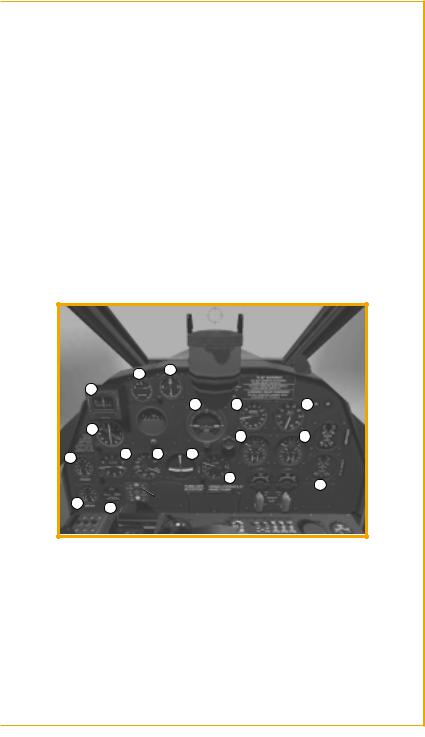
WORLD WAR II FIGHTERS
were later adapted as pathfinders, complete with a bombardier and Norden bombsight in a transparent nose. The P-38M, which arrived too late to serve in the European theater, was a two-seat night-fighter carrying a radar in a chin pod.
P-38J DATA
Engines |
Two 1,425 hp (1,062 kW) Allison V-1710-89/91 |
Wing Span |
52 ft 0 in (15.85 m) |
Length |
37 ft 10 in (11.53 m) |
Max T-O Weight |
21,600 lb (9,798 kg) |
Max Level Speed |
414 mph (666 km/h) |
Range |
450 mi (724 km) |
Armament |
One 20 mm cannon and four .50 caliber machine |
|
guns, plus up to 2,000 lb of external stores |
P-38J COCKPIT
|
|
2 |
3 |
|
|
|
|
|
|
|
|
|
1 |
|
|
|
|
|
|
|
5 |
6 |
7 |
|
4 |
|
|
|
8 |
|
|
|
|
|
|
10 |
11 |
|
12 |
|
|
|
|
|
|
|
|
|
|
|
|
14 |
|
|
15 |
16 |
17 |
|
1. |
COMPASS |
|
8. |
ENGINE GAUGE CLUSTER: |
2. |
SUCTION GAUGE |
|
|
FUEL & OIL PRESSURE, |
|
|
TEMPERATURE (LEFT ENGINE) |
||
3. |
CLOCK |
|
|
|
|
9. |
ENGINE GAUGE CLUSTER: |
||
4. |
DIRECTIONAL |
|
||
|
|
FUEL & OIL PRESSURE, |
||
5. |
ARTIFICIAL |
|
|
|
|
|
TEMPERATURE (RIGHT ENGINE) |
||
|
|
|
|
|
6. |
MANIFOLD |
GAUGE |
10. |
FRONT (RESERVE) FUEL TANKS |
|
|
|
||
7. |
TACHOMETER |
|
|
GAUGE |
|
|
|
11. |
ALTIMETER |
12.AIRSPEED INDICATOR
13.BANK AND TURN INDICATOR
14.RATE OF CLIMB INDICATOR
15.CARBURETOR AIR TEMPERATURE GAUGE
16.REAR (MAIN) FUEL TANKS GAUGE
17.HYDRAULIC PRESSURE GAUGE
26

MUSEUM COLLECTION
P-38J GAME LOADOUTS
|
|
|
|
|
Fuel, |
|
HVAR |
|
|
|
Clean |
Fuel |
HVAR |
HVAR |
500 lb |
500 lb |
1000 lb |
|
|
|
|
|
|
|
|
|
Primary Guns |
Type/Number |
.50 cal x 4 |
.50 cal x 4 |
.50 cal x 4 |
.50 cal x 4 |
.50 cal x 4 |
.50 cal x 4 |
.50 cal x 4 |
|
Location |
Fuselage |
Fuselage |
Fuselage |
Fuselage |
Fuselage |
Fuselage |
Fuselage |
|
Rounds/Gun |
500 |
500 |
500 |
500 |
500 |
500 |
500 |
|
|
|
|
|
|
|
|
|
Secondary Guns |
Type/Number |
20 mm x 1 |
20 mm x 1 |
20 mm x 1 |
20 mm x 1 |
20 mm x 1 |
20 mm x 1 |
20 mm x 1 |
|
Location |
Fuselage |
Fuselage |
Fuselage |
Fuselage |
Fuselage |
Fuselage |
Fuselage |
|
Rounds/Gun |
150 |
150 |
150 |
150 |
150 |
150 |
150 |
|
|
|
|
|
|
|
|
|
Bombs |
Type |
– |
– |
– |
– |
500 lb |
500 lb |
1,000 lb |
|
Location |
– |
– |
– |
– |
Wing |
Wing |
Wing |
|
Number |
– |
– |
– |
– |
2 |
2 |
2 |
|
|
|
|
|
|
|
|
|
Rockets |
Type |
– |
– |
HVAR |
HVAR |
– |
HVAR |
– |
|
Location |
– |
– |
Wing Racks |
Wing Racks |
– |
Wing Racks |
– |
|
Number/Rack |
– |
– |
5 |
5 |
– |
5 |
– |
|
|
|
|
|
|
|
|
|
Drop Tanks |
Type |
– |
165 US gal |
– |
165 US gal |
– |
– |
– |
|
Location |
– |
Wing |
– |
Wing |
– |
– |
– |
|
Number |
– |
2 |
– |
2 |
– |
– |
– |
|
|
|
|
|
|
|
|
|
MESSERSCHMITT BF 109
Perhaps the most famous German fighter ever built, the Bf 109 earned a place in the annals of all-time great warplanes by virtue of its early-war performance alone—to say nothing of the fact that it faithfully served as the mainstay of the Luftwaffe from before hostilities commenced in 1939 until the capitulation of Germany in May 1945. A fundamentally good design allowed it to be employed in an incredibly wide variety of tasks, and the fact that some 35,000 were built speaks volumes of the airplane’s usefulness.
In 1933 the Reichsluftfahrtministerium (Air Transport Ministry), or RLM, issued a specification for a monoplane fighter to replace the biplane fighters (Arado Ar 68 and Heinkel He 51) then available to the still-clandestine Luftwaffe. Contracts for prototypes were awarded to Arado, Bayerische Flugzeugwerke, Focke-Wulf, and Heinkel. Few expected Willy Messerschmitt and Bayerische Flugzeugwerke to produce a winning design in the area of high speed fighters, whatever the success of their earlier Bf 108 Taifun touring airplane. When it came time for competitive trials, however, Messerschmitt’s Bf 109 V1 performed admirably against the Ar 80 V1, Fw 159 V1, and He 112 V1. A low wing monoplane with retractable landing gear, the 109 was clearly a breed apart from the open cockpit designs proposed by Arado and Focke-Wulf, or Heinkel’s high-wing fighter. The RLM ordered an additional 10 experimental Bf 109s, but—hedging their bets perhaps—ordered 10 of the Heinkel design as well. This led to further trials in late 1935, during which the Bf 109 proved its superiority.
27

WORLD WAR II FIGHTERS
Ironically, the 109 first flew under the power of imported Rolls-Royce Kestrel VI engine, since the Jumo 210 engine intended for it was not finished.
The proposed Bf 109A was cancelled when its armament of just two 7.9 mm MG 17 machine guns in the upper cowling was deemed inadequate. Provision was made for a possible third gun firing through the airscrew, and a number of Bf 109B-1, B-2, and C fighters were delivered to Luftwaffe units operating with the Condor Legion in Spain. Pilots gained considerable experience while participating in the Spanish Civil War, formulating tactics and suggesting improvements to the 109, which already was proving capable of going head-to-head with the best Republican fighter, the Russian-built Polikarpov I-16.
The Bf 109D powered by the Daimler-Benz DB 600 engine was produced in limited quantities, but by the time the war broke out in 1939, the Bf 109E with the more powerful 820 kW (1,100 hp) DB 601A engine was taking the place of the ‘Dora’ on the production lines. The 109E or ‘Emil’ housed additional MG 17 machine guns or 20 mm MG FF cannon in the wings, and some variants housed a fifth MG FF cannon in the propeller hub. The Emil was produced in great numbers—it was the primary fighter used in the Battle of France and the Battle of Britain—and many were exported to foreign clients in return for hard cash. The airplane’s tremendous speed advantage was its greatest asset in the first few years of the war. It suffered against early RAF Spitfires in the area of turning performance, and its fuel capacity was small (a serious liability, as the Germans discovered, during the Battle of Britain), but otherwise the Bf 109E was the superior machine. The ‘Emil’ began to take on additional roles: fighter-bomber, reconnaissance airplane, high-altitude interceptor with power-boosting, and a modified version for fighting in the Mediterranean.
By the time Germany invaded the Soviet Union in 1941, the Bf 109F was being introduced. This airplane—now powered by an 894.2 kW (1,200 hp) DB 601N or 969 kW (1,300 hp) DB 601E engine—eliminated the aerodynamically unattractive braces under the tailplane while introducing a retractable tailwheel. The wing guns were eliminated entirely—pilots would now rely on a pair of MG 17s in the upper nose deck, and a single high-velocity MG 151/20 cannon firing through the airscrew.
In the summer of 1942, the Luftwaffe introduced the Bf 109G into service. This model was powered by the 1,100 kW (1,475 hp) DB 605 series of engines, the intention being to increase the airplane’s speed performance at the expense of maneuverability. The ‘Gustav’ was built in larger numbers than any other variant of the 109—despite the fact that it was no longer the equal of the newest Allied fighters—and G models would continue to roll off the production line until the end of the war. A few other other versions were also developed, including the high-altitude Bf 109H (with increased wing span) and the Bf 109K, which was basically an improved 109G.
28
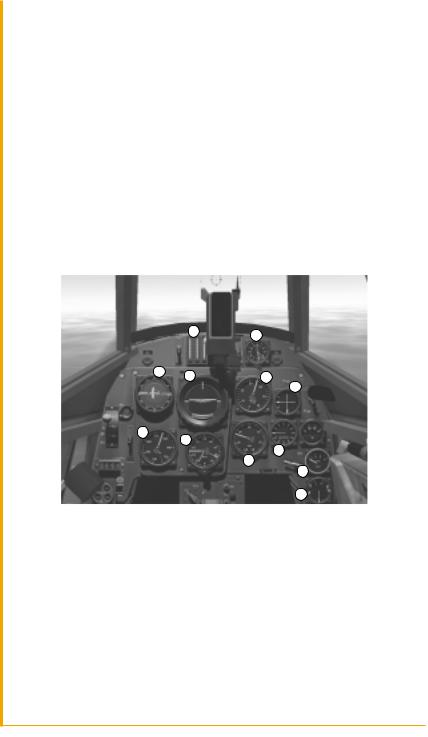
|
MUSEUM COLLECTION |
BF 109G-6 DATA |
|
Engines |
One 1,099-1,490.4 kW (1,475-2,000 hp) Daimler-Benz |
|
DB 605 |
Wing Span |
9.92 m (32 ft 6.5 in) |
Length |
8.84 m (29 ft .5 in) |
Max T-O Weight |
3,150-3,678 kg (6,945-8,109 lb) |
Max Level Speed |
621 km/h (386 mph) |
Range |
563 km (350 mi) |
Armament |
One 30 mm MK 108 cannon, two 12.7 mm MG 131 |
|
machine guns, and (optional) two 20 mm MG 151 |
|
cannon. One 250 kg bomb or 500 kg bomb with |
|
release take-off carriage. |
BF 109G-6 COCKPIT
|
|
1 |
|
2 |
|
|
|
|
|
|
3 |
4 |
|
5 |
|
|
|
||
|
|
|
|
6 |
|
7 |
|
|
|
|
|
|
|
10 |
|
|
|
|
9 |
|
|
|
|
11 |
|
|
|
|
|
1. |
AMMUNITION COUNTERS |
|
7. |
ALTIMETER |
2. |
CLOCK |
|
8. |
AIRSPEED INDICATOR |
3. |
COMPASS |
|
9. |
TACHOMETER |
4. |
TURN AND BANK INDICATOR/ |
|
10. PROPELLER PITCH INDICATOR |
|
|
ARTIFICIAL HORIZON |
|
11. FUEL GAUGE |
|
|
|
|
||
5. |
MANIFOLD PRESSURE GAUGE |
|
12. OIL AND PRESSURE GAUGE |
|
|
|
|
||
6. |
RADIO DIRECTION FINDER |
|
|
|
29
